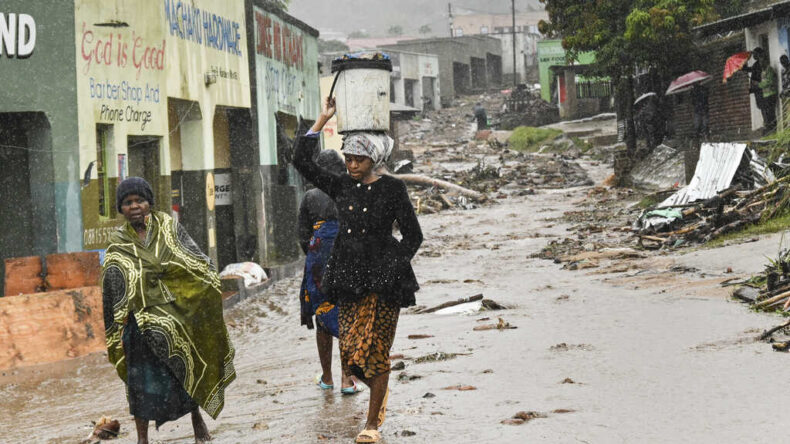The still-flooded nation of Mozambique is dealing with a growing cholera outbreak that threatens to exacerbate the catastrophe weeks after the powerful Freddy Cyclone struck the region twice.
Highlights

Freddy Cyclone: Longest-lasting, Deadliest Impact
According to the United Nations Office for the Coordination of Humanitarian Affairs, there were over 19,000 confirmed cases of cholera in eight different provinces of Mozambique as of March 27. This number had nearly doubled in a week.
Freddy Cyclone, which affected Mozambique twice and lasted more than five weeks, was probably the longest-lasting cyclone ever. 165 persons perished in Mozambique, 17 in Madagascar, and 676 in Malawi as a result of the tropical storm. Two weeks later, more than 530 individuals are still listed as missing in Malawi, and there may be more than 1,200 fatalities there. In the Zambezia province of Mozambique, where many villages are still underwater and the water supply is still tainted, Freddy made its second landfall.
Cholera Pandemic in Mozambique: Health Crisis Deepens
Eduardo Sam Gudo Jr., director general of the National Institute of Health, stated at a hospital in Quelimane, the provincial seat of Zambezia, that there were 600 new confirmed cases a day in only the Quelimane district, but added that the actual figure might be as high as 1,000. According to data from the Ministry of Health, approximately 3,200 people were admitted to hospitals between March 15 and March 29 due to cholera, and at least 31 people died as a result. The number of cases is largest in the city’s outskirts area of Icidua, where most residents live in bamboo or adobe mud huts and carry buckets of water to their homes.

Many of these wells were exposed to sewage overflow and other sources of bacterial contamination due to flooding caused by the cyclone. When cholera enters drinking water, it generally spreads through feces. But until the flood-damaged water pipelines are rebuilt, these wells are the only supply of water for residents of Icidua and other settlements. The only possibility of stopping the pandemic, for the time being, is through short-term fixes.
Health professionals are currently having difficulty treating the infected because of the several heavily damaged clinics and hospitals. José da Costa Silva, the clinical director of the Icidua health center, claimed that “the cyclone wrecked the infrastructure here.” We are completing our work in the hospital’s unharmed areas. Since there isn’t enough room for everyone, some coworkers work in the open. Freddy’s two landfalls in Mozambique, in total, had an impact on 80 health centers, according to INGD, the nation’s disaster management organization.
Climate Change & Cyclone Freddy’s Unprecedented Journey

Although tropical cyclones hit southern Africa from December to May, human-caused climate change has increased their intensity, frequency, and wetness. Moreover, the now-passed natural La Nina episode exacerbated cyclone activity in the area. Although Cyclone Freddy itself has not yet been linked to global warming, researchers claim that it exhibits all the characteristics of a warming-driven weather catastrophe.
The cyclone of unusual duration, which developed in early February in Australia, completed an unparalleled journey of more than 8000 kilometers (5,000 miles) from east to west across the Indian Ocean. It traveled in a loop that was rarely observed by meteorologists, first making landfall in Mozambique and Madagascar at the end of February, then returning in March before slamming into Malawi.
It will take some time for Mozambique’s water supplies to return to normal because numerous damaged pipes pass through regions that are still inaccessible two weeks after the cyclone’s last impact. Rural villages close to Quelimane are additionally at peril. The humidity has produced swarms of mosquitoes transmitting malaria, and many communities and farmland are still under water.
Malaria Outbreak in Mozambique’s Flooded Camps
According to a local chief named Hilário Milisto Irawe, 20 out of 290 people living in a temporary camp on the edge of a flooded rice field close to the community of Nicoadala are suffering from malaria. On the 24th of March alone, 444 instances of malaria were registered in the Quelimane region, but the actual number is probably much higher because many people, like those living in the camp outside of Nicoadala, lack access to medical facilities.
Since Freddy struck just before the primary harvest, the material livelihoods of hundreds of people are in jeopardy, thus exacerbating the public health problem. Also, it brought seawater inland, endangering the soil’s long-term fertility in a region where chronic hunger is already a problem. “All of our farms are underwater. Our rice farms have been wiped off. All we can do is start over, but we have no idea how to do it,” Irawe added.
Read More: More than 220 killed by Cyclone Freddy













